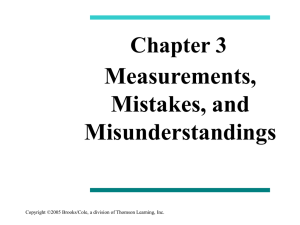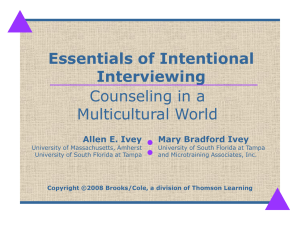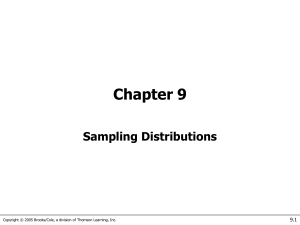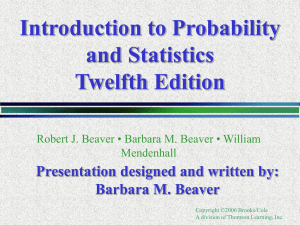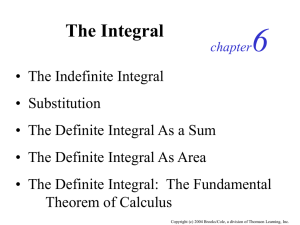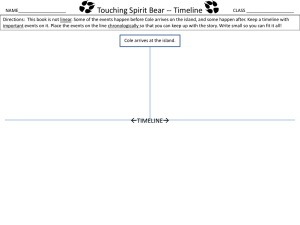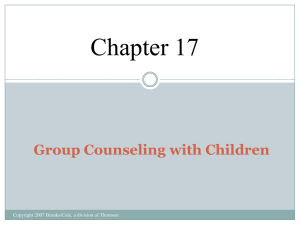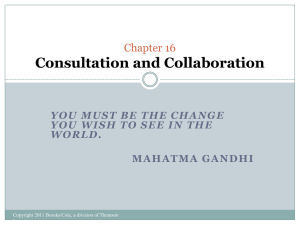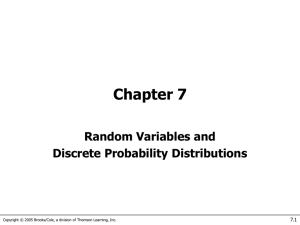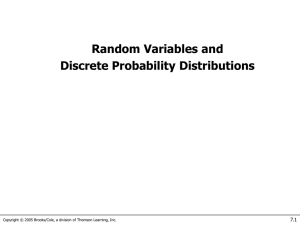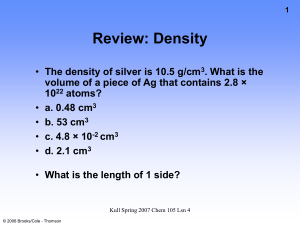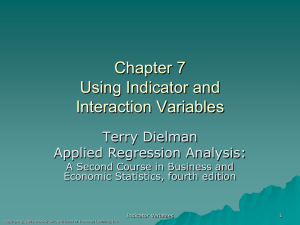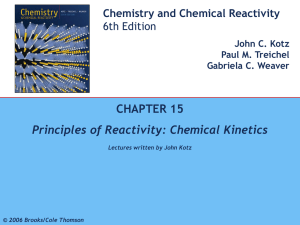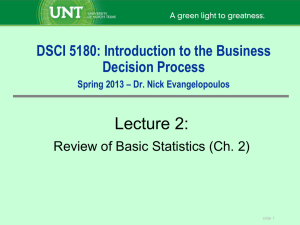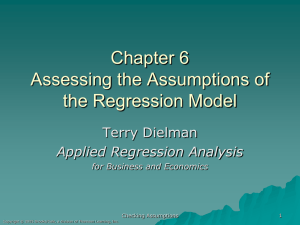Chapter 2 Ethics, Multicultural Competence, and Wellness
advertisement
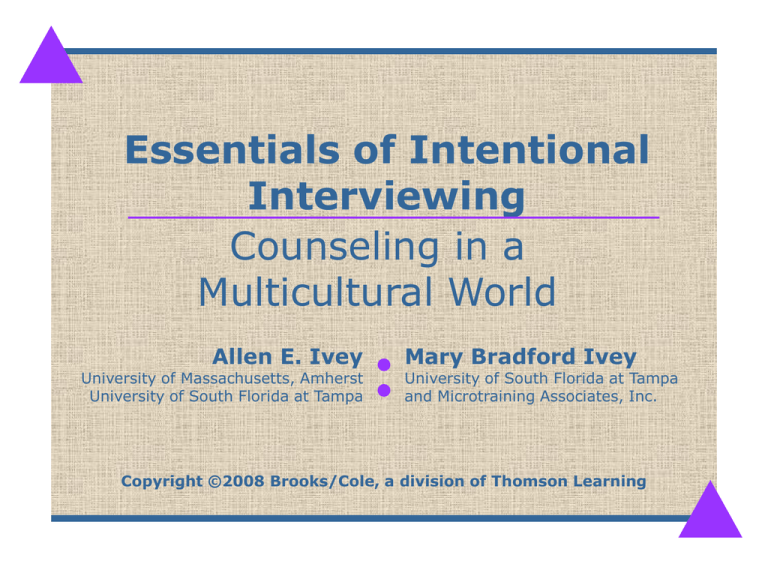
Essentials of Intentional Interviewing Counseling in a Multicultural World Allen E. Ivey University of Massachusetts, Amherst University of South Florida at Tampa Mary Bradford Ivey University of South Florida at Tampa and Microtraining Associates, Inc. Copyright ©2008 Brooks/Cole, a division of Thomson Learning Chapter 2 Ethics, Multicultural Competence, and Wellness Copyright ©2008 Brooks/Cole, a division of Thomson Learning Chapter Goals Slide One Apply key ethical principles. Develop your own informed consent form. Define multicultural competence. Apply wellness and positive psychology in an assessment interview. Copyright ©2008 Brooks/Cole, a division of Thomson Learning Ethics In the Helping Profession, Slide One Major helping professions outline code guides for ethical practice. Codes empower professionals/trainees to: Keep good practice Protect their clients Safeguard their autonomy Enhance the profession Copyright ©2008 Brooks/Cole, a division of Thomson Learning Ethics In the Helping Profession, Slide Two Competence Informed Consent Confidentiality Power Social Justice Copyright ©2008 Brooks/Cole, a division of Thomson Learning Competence Ethics In the Helping Profession Practice within the boundaries of your own competence. Boundaries include education, training, supervised experience, recognized professional credentials, and professional experience. Recognize your limitations and seek supervision as required. Refer clients as necessary. Copyright ©2008 Brooks/Cole, a division of Thomson Learning Informed Consent Ethics In the Helping Profession Clients have the right to participate in ongoing counseling plans. Keep clients informed of pertinent elements, as necessary, before, during, and after sessions: (including, but not limited to) ~ ~ ~ ~ ~ ~ ~ Goals Procedures and techniques Risks and benefits Confidentiality Boundaries of competence Limitations Fee collection and record keeping Copyright ©2008 Brooks/Cole, a division of Thomson Learning Confidentiality Ethics In the Helping Profession Trust is built on your ability to keep confidences. Recognize and maintain compliance with state codes regarding confidentiality. Communicate the parameters of confidentiality in a culturally competent manner. Copyright ©2008 Brooks/Cole, a division of Thomson Learning Power Ethics In the Helping Profession Power differentials occur where privilege may go with skin color, gender, sexual orientation, or other multicultural dimensions. Dual relationships may increase conflict of interest, risk of harm, or client exploitation. Maintain awareness and open discussion; work toward a balance of power in helping sessions. Copyright ©2008 Brooks/Cole, a division of Thomson Learning Social Justice Ethics In the Helping Profession Is the problem, concern or challenge “in the client.” “in the environment,” or in some balance of the two? Is the interviewer’s task completed when the session is over? Maintain awareness of cultural / environmental / social context of the client. Copyright ©2008 Brooks/Cole, a division of Thomson Learning Multicultural Practice Diversity and Multicultural Comptetence Dimension 1: Be aware of your own assumptions, values, and biases Dimension 2: Understand the worldview of the culturally different client. Dimension 3: Develop appropriate strategies and techniques Copyright ©2008 Brooks/Cole, a division of Thomson Learning Dimension 1 Awareness of Assumptions, Values, and Biases Must have self awareness in order to develop self awareness in others. Know your cultural background and the distinction between self and client. Recognize your limitations and refer as necessary. Copyright ©2008 Brooks/Cole, a division of Thomson Learning Dimension 2 Understanding the Culturally Different Client’s Worldview How do clients see themselves and the world around them? Learn the client worldview; do not impose interviewer views on the client. Some traditional approaches may be inappropriate or ineffective with some groups. Continue learning worldviews through academic study, reading, and living experience. Copyright ©2008 Brooks/Cole, a division of Thomson Learning Dimension 3 Developing Appropriate Intervention Strategies and Techniques Expand skills in traditional strategies and newer methods. Use traditional theory in a more culturally respectful manner. Build awareness of cultural bias in testing instruments and assessment processes. Adapt present methods to be more culturally sensitive. Engage in varied helping responses to support multicultural clients. Copyright ©2008 Brooks/Cole, a division of Thomson Learning Diversity and Ethics Developing Appropriate Intervention Strategies and Techniques Helpers are committed to the dignity and value of each individual. We can enhance individuality the more we understand we are all part of multiple cultures. Multicultural includes sexual orientation, age, gender, geographic location, physical ability, religion, socioeconomic status, and other factors. All interviewing and counseling is multicultural; seek the “win-win” approach. Helpers need to address own personal issues of prejudice and racism. Adapted from Mark Pope, Cherokee Nation and Past President of the American Counseling Association, Box 2-3, pg. 30. Copyright ©2008 Brooks/Cole, a division of Thomson Learning Wellness Positive Psychology Problem solving requires client strengths. Identify strengths and known resources to improve client approach to complex issues. (Tyler, 1961) Focus on building strength and resilience rather than damage repair. (Seligman, 2002) Story – positive asset – restory – action model guides search for strength and resources. Copyright ©2008 Brooks/Cole, a division of Thomson Learning Positive Orientation Drawing Out Client Stories Listening Strength Development New Perspectives Action Planning Copyright ©2008 Brooks/Cole, a division of Thomson Learning Wellness Assessment Positive Psychology Expand skills in traditional strategies and newer methods. Use traditional theory in a more culturally respectful manner. Build awareness of cultural bias in testing instruments and assessment processes. Adapt present methods to be more culturally sensitive. Engage in varied helping responses to support multicultural clients. Copyright ©2008 Brooks/Cole, a division of Thomson Learning Wellness Assessment Positive Psychology The Essential Self The Social Self The Coping Self The Creative Self The Physical Self Copyright ©2008 Brooks/Cole, a division of Thomson Learning The Essential Self Dimension 1, Wellness Assessment Spirituality Be specific. What strengths and supports do you gain from your spiritual/religious orientation? Gender Identity What strengths do you draw from your gender? Your sexual orientation? Copyright ©2008 Brooks/Cole, a division of Thomson Learning The Essential Self Dimension 1, Wellness Assessment Cultural Identity What strengths do you draw from your race? Your ethnicity? Self Care How well do you care for yourself? Do you avoid drugs and alcohol? Copyright ©2008 Brooks/Cole, a division of Thomson Learning The Social Self Dimension 2, Wellness Assessment Friendship Tell me about your friends and what strengths they provide you. Love Please share some positive family stories. What are some positive memories about grandparents, parents, siblings, or your extended family. Copyright ©2008 Brooks/Cole, a division of Thomson Learning The Coping Self Dimension 3, Wellness Assessment Leisure What leisure activities do you enjoy? Do you take time to enjoy them? Stress-Management What are specific skills you use to cope with stress? Do you remember to use these strategies? Copyright ©2008 Brooks/Cole, a division of Thomson Learning The Coping Self Dimension 3, Wellness Assessment Self-Worth What gives you a sense of worth and self-esteem? Realistic Beliefs Do you have realistic beliefs about yourself and your abilities. Copyright ©2008 Brooks/Cole, a division of Thomson Learning The Creative Self Dimension 4, Wellness Assessment Thinking Could you give an example of when positive thinking worked for you? Emotions When have you felt and expressed emotion with a good results? Negative emotion? Positive emotion? Copyright ©2008 Brooks/Cole, a division of Thomson Learning The Creative Self Dimension 4, Wellness Assessment Control When have you been able to control a difficult situation in a positive way? Work What jobs have you enjoyed and been most proud? Positive Humor What makes you laugh? Copyright ©2008 Brooks/Cole, a division of Thomson Learning The Physical Self Dimension 5, Wellness Assessment Exercise How well does your present weight and eating habits reflect good nutrition? Nutrition What do you do for exercise? Copyright ©2008 Brooks/Cole, a division of Thomson Learning Chapter 2 Skills Practice Ethics, Multicultural Competence, and Wellness Copyright ©2008 Brooks/Cole, a division of Thomson Learning Group Practice Exercise Ethics, Multicultural Competence, and Wellness Examine your multicultural background. Develop an informed consent form. Practice a wellness interview. Copyright ©2008 Brooks/Cole, a division of Thomson Learning Multicultural Background Ethics, Multicultural Competence, and Wellness Separate into groups of three. Review the RESPECTFUL Model. Discuss each dimension briefly. Identify your multicultural self. Because of being from a specific group, do you (or not) have more privileges and advantages? What would it be like for you to be more (or less) privileged in each area? Copyright ©2008 Brooks/Cole, a division of Thomson Learning Informed Consent Develop An Informed Consent Form Separate into groups of four. Review the Informed Consent Form from the text. (Box 1-3, p. 19) What are your reactions to the form? How would you change the form for this course? Copyright ©2008 Brooks/Cole, a division of Thomson Learning Wellness Interview Conduct a Wellness Interview for Practice Separate into groups of three. Person 1: client Person 2: interviewer, using Myers/Sweeny wellness concepts. Person 3: observer What strengths can you identify in the identified client? Client and observer complete Client Feedback Form. (Box 1-3, p. 19) Copyright ©2008 Brooks/Cole, a division of Thomson Learning
